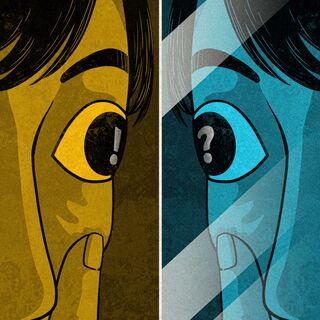Personality
Enabling Borderline Personality Disorder II
Part 2: BPD Self-Enabling.
Posted January 9, 2021 Reviewed by Kaja Perina
Part 1 looked at how efforts to help those with Borderline Personality Disorder (BPD) can make the illness worse if those efforts are not properly directed. This part will look at how individuals with BPD might be making their illness worse in trying to help themselves.

Self-Enabling
This occurs when efforts at trying to help oneself actually make the illness worse. These efforts are generally targeted at short term symptom relief and often successfully reduce symptoms in the short term while making them worse in the long term. For example, an alcoholic experiences symptoms of withdrawal after alcohol cessation. These symptoms can include shaking and even seizures. Drinking more alcohol in the short term will make these symptoms go away temporarily but they increase the level of addiction and guarantee that worse symptoms will follow the next effort at sobriety.
Some individuals with BPD defend their symptoms rather than condemn them. Here are some comments from individuals who have criticized my efforts to attack this disease and help sufferers free themselves.
Comment # 1
“Have you any idea what a battle it is to be given this diagnosis (in my case post-children)? How dare you paint mothers with this terrible mental illness with the same brush.”
Comment # 2
“I am the mother of 2 adult children. I am also Borderline. I am not BRUTAL! My daughter & I are extremely close while my son has chosen estrangement.”
Comment # 3
“The truth is when our buttons are pressed we have very little to NO control over how anything goes down.”
Comment # 4
“And we know what the truth is when we're not going off, we do not have mental impairment many of us are quite intelligent.”
Comment # 5
“Another article bashing people who happen to suffer from Borderline personality disorder... increasing the stigma that already exists and keeps so many who suffer from getting help.”
Comment # 6
“My mother wore her victimhood proudly. She actually proclaimed that it was good to suffer, because it made her good in the eyes of God.”
One commonality between all of the above comments is that each of the writers identifies with the illness and defends it as a part of themselves. This identification with the illness and the associated defensiveness and protectiveness underlies several aspects of self-enabling. Some of them are listed below.
Refusal to Take Responsibility
In comment #1, the writer explains that mothers cannot have BPD and therefore she is not responsible for her behavior. In #2 the writer explains that her behavior is not “brutal” but one out of two of her children is estranged, presumably for some other reason. In #3 the writer explains that she cannot control her behavior when other people say things to her that she does not like, so it is not her fault, it is because someone ‘pushed her button’. #4 explains that since she is fine when she is “not going off”, therefore she is not responsible for going off (lashing out at others). #6 describes that her mother was actually proud of the BPD associated behaviors.
Healing and growth require that a person take responsibility for their choices and behaviors. The only way we have the power to heal ourselves and grow is to have control, and with control comes responsibility.
Taking responsibility is not the same as taking blame. The goal of healing and growth requires empowerment through self-control.
Entitled to Greater Tolerance From Others Due to BPD
In comment #1 the writer suggests that others, including professionals, should avoid diagnosing them with BPD, even though they have it, because it is too painful. Comments #3 and 4 suggest that others need to be tolerant of their lashing out behaviors because either they can’t control it or they sometimes don’t lash out. #5 suggests that labeling and discussing hurtful behaviors caused by BPD inhibits individuals from getting help, and feels that others should not mention when they are being hurt by the illness.
Greater tolerance of symptoms often makes them worse. If you experience pain from straining your ankle, but try to tolerate the pain so that you can continue playing sports, you will most likely make your condition worse. Similarly, greater tolerance for BPD symptoms, such as lashing out at others when frustrated, reinforces the symptom's efficacy and hence it’s utilization. Healthy people don’t tolerate symptoms, they seek to cure or weaken them.
Reinforces Victim Identification
In comment #1 the writer suggests that she was victimized by being given a diagnosis, even though she apparently thinks the diagnosis is correct. In comment #3 the writer expressed feeling victimized because she has “very little to NO control over how anything goes down.” In #5 the writer expressed that she is victimized by discussions about people who have been hurt by this disease to such an extent that it prevents seeking help. Perhaps the most self-enabling is the description of the writer of the mother who “wore her victimhood proudly”, somehow seeing it as a virtue to be sick.
Identifying oneself as a victim is unhealthy. It is a position of passivity associated with having one’s fate in the hands of others. Individuals who have been victimized need to see themselves as survivors, not victims. Survivors are former victims who have empowered themselves to heal and grow.
If you are affected by BPD, you should not embrace it or feel proud or entitled because you have it. You should feel proud for being a front-line fighter of BPD and using your best efforts to protect your family. For this you are a hero. You should hate BPD and seek to weaken it or destroy it and you should band together with your family and the medical community to provide assistance and support as you battle this formidable foe.




